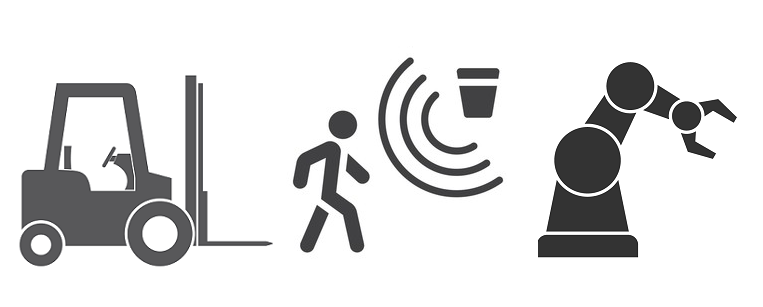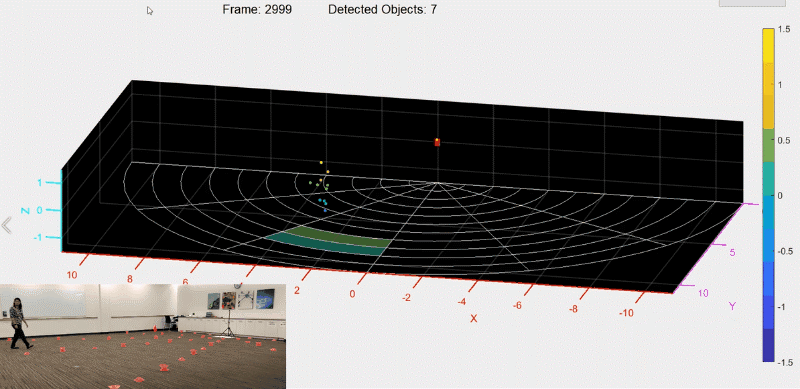SSZT640 august 2018 IWR1443
As automation revolutionizes our world – buildings, homes, cities and now factories leverage intelligent automation— the process chain becomes more efficient and easier to maintain. In factory automation, both fixed and mobile robots are used for various applications, from manufacturing to packaging. In functions that depend heavily on man and machine working “hand in hand,” there is a possibility for potential obstacles on the factory floor, such as humans, autonomous vehicles or static objects. This introduces the need for incident management through process control safety guards, such as safety curtains and area scanners in factories. These safety guards can detect whether a human or an object is in close proximity to a robot, as shown in Figure 1.
 Figure 1 Examples of Machines That
Require an Area Scanner to Determine the Proximity of a Human or Object to a
Robot
Figure 1 Examples of Machines That
Require an Area Scanner to Determine the Proximity of a Human or Object to a
RobotSome of the key features you should look for in a safety guard sensor include:
- The resolution at which the object can be detected.
- The coverage area.
- The accuracy of object detection in a variety of environmental and lighting conditions.
- The response time.
TI’s millimeter-wave (mmWave) sensor enables the detection of objects across many environmental conditions. mmWAve sensors are not sensitive to environmental conditions such as dust, water or bright or low-light . This solution provides both elevation and azimuth information at the edge to enable high accuracy to detect objects and avoid collisions in automated robotics, transportation, and more.
Figure 2 shows how TI’s mmWave sensors such as the IWR1443 can measure range, velocity and position information to determine an object’s distance from a sensor on the robot to determine zone occupation. The Zone Occupancy Detection Reference Design Using mmWave Sensors uses the IWR1443 evaluation module to depict a 3D point-cloud view around the robot. In this example, the sensor is mounted on the wall to get optimal results. However, the sensor can also be mounted in an overhead position.
 Figure 2 Point-cloud Detection of a
Human in the Defined Zone Using TI’s IWR1443 mmWave Sensor
Figure 2 Point-cloud Detection of a
Human in the Defined Zone Using TI’s IWR1443 mmWave SensorHigh resolution, wide field of view, and static clutter removal are all key considerations when designing industrial safety guards. Table 1 outlines these performance areas for TI’s mmWave sensors.
| mmWave benefits for safety guards around robots in factories | ||
| mmWave device performance with the IWR1443 | Application benefit | |
| Tuning range | 76-81GHz | A 4GHz-wide bandwidth provides a very low range resolution to separate objects in close proximity |
| Maximum range (resolution) | 10m (0.047m) | Used as area scanner or an arm safety curtain to maintain a no-entry curtain or zone around the equipment |
| Maximum field of view (resolution) | 120 degrees (15-degree angular resolution) | Wide area detection and tracking of multiple moving objects such as people for incident management |
| Static clutter removal | Yes | Filters out nonmoving objects to accurately detect people or vehicles |
The reference design also features a static clutter-removal algorithm that enables the sensor to distinguish between static objects such as a pole or fence and moving objects approaching the sensor. With a 4.7cm range resolution, the sensor is capable of detecting various objects at different distances up to 10m. In addition, a 26cm-per-second velocity resolution enables accurate tracking of objects approaching a robot. A 120-degree field-of-view (FOV) capability with a 15-degree angular resolution enables a wider field of view to detect moving objects and humans across an entire “safety zone.”
| Degrees | 1m | 3m | 4m | 5m | 6m | 7m | 8m | 9m | 10m | 11m |
| 0-30 | x | x | x | |||||||
| 30-60 | x | x | x | x | x | x | x | x | ||
| 60-90 | x | x | x | x | x | x | x | x | x | x |
| 90-120 | x | x | x | x | x | x | x | x | x | |
| 120-150 | x | x | x | x | x | x | x | x | ||
| 150-180 | x | x | x | x |
MmWave sensors provide high resolution, reliable accuracy, and a wide field of view for designing safety guard systems. By enabling industrial robots and transport vehicles to detect moving objects (such as people, other robots or vehicles) and static objects (such as a pole or wall), mmWave sensors can help minimize hazards on the factory floor. In addition to the benefits of mmWave technology, TI’s mmWave sensors are a single-chip integrated solution that provides a low system cost and easy design execution with available software and reference designs.
Check out our video below to see how mmWave sensors work to prevent collisions on the factory floor.
To explore and address the challenges in industrial automation, learn more about IWR mmWave solutions.
Additional Resources
- Download the IWR1443 data sheet.
- Get started with mmWave software development kits.
- Read more about mmWave for industrial transportation systems on our blog.
- Watch the video demonstration to learn how robots sense and avoid with mmWave sensors.
- Check out the ingredients you need to make Industry 4.0 a reality